You’ve received an invitation for a work event, a nice dinner, or a weekend gathering, and the requested attire is “Smart Casual.” This seemingly simple phrase is one of the most common—and most confusing—dress codes in the modern man’s life. It sits in a nebulous zone between a formal suit and relaxed weekend wear, leaving many to wonder: what is smart casual dress code for men? Is it a blazer with jeans? A nice shirt without a tie? The ambiguity can cause significant sartorial stress, as getting it wrong can make you feel either overdressed or underdressed.
This comprehensive guide is designed to be your definitive resource for demystifying the smart casual dress code. We will move beyond vague definitions to provide a clear, practical framework for building outfits that are both polished and comfortable. Understanding what is smart casual dress code for men is not about memorizing a single outfit, but about learning a versatile style language that balances sophistication with personal expression. Whether for the office, a date, or a social event, this article will equip you with the principles and components to navigate this dress code with unwavering confidence.
Decoding the Philosophy: The Core of Smart Casual

At its heart, smart casual is about intentional, elevated relaxation. It’s the art of looking put-together without looking like you’re trying too hard. The “smart” element implies neatness, impeccable fit, and thoughtful coordination. The “casual” element allows for comfort, softer fabrics, and more personal expression than traditional business attire.
Think of it as “casual clothes worn in a smart way.” It’s not about throwing on any clean t-shirt and jeans; it’s about selecting well-fitting, quality pieces that work harmoniously to create an impression of competence and effortless style. The goal is to look appropriate for a professional or social setting without being rigid or formal.
The Foundation: Key Components of a Smart Casual Wardrobe
Mastering smart casual involves understanding how to upgrade key elements of a casual outfit while avoiding the formality of a full suit and tie. Here are the building blocks.
The Versatile Tops
Your choice of top sets the tone for the entire outfit.
- The Button-Down Shirt: A classic Oxford cloth button-down is a perfect starting point. It can be worn tucked or untucked (if the hem is designed for it) and works in nearly every smart casual scenario. Other excellent choices include poplin or chambray shirts.
- The Polo Shirt: A high-quality pique or jersey polo shirt in a solid, neutral color is an excellent smart casual staple. Ensure it fits well—sleeves should hit mid-bicep and the body should skim your torso without being tight. Avoid large logos.
- The High-Quality Knit: A fine-gauge merino wool, cashmere, or high-quality cotton sweater adds a layer of sophistication. A V-neck over a collared shirt is a classic combo, while a stylish crewneck can be worn with a t-shirt or on its own.
- The Casual Blazer or Sport Coat: This is the ultimate smart casual piece. An unstructured blazer in linen, cotton, corduroy, or tweed instantly elevates any outfit. It’s more relaxed than a suit jacket, often featuring patch pockets and softer shoulder construction.
What to Avoid: Graphic tees, worn-out band t-shirts, hoodies, and athletic jerseys.
The Essential Bottoms
Your choice of trousers anchors the outfit and defines its level of formality.
- Chinos: The undisputed king of smart casual bottoms. Opt for a flat-front style in a classic color like khaki, navy, grey, or olive. The fit is paramount—it should be tailored but not tight, with a slight taper.
- Dark-Wash Jeans: Yes, jeans can be smart casual if they are dark, free of rips and excessive fading, and have a straight or slim fit. The denim should have a clean, uniform color. Avoid baggy, light-wash, or distressed styles.
- Dress Trousers (Casual Cuts): Wool or tropical wool trousers in a neutral color can work, but they should be less formal than your suit separates—think softer fabrics, patterns like subtle herringbone, and more relaxed cuts.
What to Avoid: Cargo pants (with bulky pockets), athletic sweatpants, joggers, and shorts (unless the setting explicitly calls for them).
The Finishing Touches: Footwear and Accessories
Shoes and accessories can make or break a smart casual look.
- Footwear:
- Leather Loafers: Penny loafers, horsebit loafers, or driving moccasins are a quintessential and sophisticated choice.
- Clean Leather Sneakers: Minimalist, plain white, black, or grey leather sneakers are acceptable and modern. They should be pristine and free of loud colors or prominent athletic branding.
- Desert Boots / Chelsea Boots: Both offer a stylish, slightly rugged yet polished aesthetic. Suede or leather versions are equally versatile.
- Brogues or Derbies: Less formal than Oxfords, these are a great choice, especially in suede.
- Accessories:
- A leather belt that matches your shoe color is a simple but crucial detail.
- A quality watch is the most functional and stylish accessory a man can wear.
- Socks should be deliberate—either matching your trousers for a seamless look or making a subtle statement with a pattern. Avoid white athletic socks with smart shoes.
Situational Style: Adapting the Smart Casual Code
What is smart casual dress code for men can shift depending on the environment. Here’s how to adapt.
The Smart Casual Office
This is typically a more polished version of the code.
- Outfit Formula: Chinos or dress trousers + a button-down shirt or polo + a blazer (optional but recommended). Leather shoes like loafers, derbies, or clean sneakers are all appropriate.
- Key Takeaway: Denim might be acceptable, but it’s wise to confirm the company culture first. When in doubt, opt for chinos.
A Dinner, Date, or Social Event
This allows for more personal expression and a slightly relaxed feel.
- Outfit Formula: Dark-wash jeans + a high-quality knit or a button-down shirt (tucked or untucked) + leather boots or sleek sneakers. A blazer can still be added for a more polished look.
- Key Takeaway: This is where your personality can shine through with color, texture, and accessory choices.
A Summer or Daytime Event
Lighter fabrics and colors are not just appropriate but encouraged.
- Outfit Formula: Linen or cotton trousers + a short-sleeve button-up or a high-quality polo shirt + loafers or minimal sneakers.
- Key Takeaway: Embrace breathable fabrics and a more relaxed color palette.
The Golden Rules of Smart Casual
Regardless of the specific items, three principles are non-negotiable for mastering this dress code.
- Fit is King: This is the single most important factor. A $50 shirt that fits perfectly will look smarter than a $500 shirt that is too baggy or tight. Clothes should skim the body, not cling to it or swim on it. Pay close attention to the shoulder seams of shirts and jackets, the waistband of trousers, and the sleeve length.
- Fabric and Quality Matter: Smart casual relies on fabrics that look considered and intentional. Think natural fibers and high-quality blends like cotton, linen, wool, and cashmere. These materials drape better, last longer, and look more sophisticated than cheap, synthetic fabrics that can appear shiny or pilled.
- Neatness and Grooming: The “smart” part of the equation extends beyond your clothes. Your garments should be clean, pressed (if necessary), and in good repair. Personal grooming—neat hair, trimmed facial hair, and clean nails—completes the polished look and is essential to the overall impression.
Common Smart Casual Pitfalls to Avoid
- The Overly Formal Mistake: Wearing a full suit with a tie to a smart casual event will make you look out of touch and uncomfortable. If you wear a suit jacket, lose the tie and pair it with more casual trousers like chinos or dark denim.
- The Too-Casual Mistake: Relying on gym wear, beachwear, or loungewear items. Hoodies, baseball caps, graphic tees, and flip-flops are almost never smart casual.
- The Logomania Trap: Clothing covered in large, visible logos is generally considered tacky and moves away from “smart” towards ostentatious. The focus should be on cut and quality, not branding.
- The Fit Fiasco: Baggy, ill-fitting clothes look sloppy, while clothes that are too tight look unprofessional and uncomfortable. Always err on the side of a tailored, but not tight, fit.
Frequently Asked Questions
Can I wear jeans for a smart casual dress code?
Yes, but with strict caveats. The jeans must be in a dark wash (indigo or black), be free of rips, tears, and excessive fading, and have a clean, tailored fit (straight or slim). Avoid baggy, light-wash, or heavily distressed jeans. The key to making jeans smart casual is to balance them with more polished items on top, like a blazer or a structured shirt, and smart shoes.
Are sneakers considered smart casual?
Minimalist, clean leather sneakers are now widely accepted in smart casual dress codes. Think all-white, all-black, or grey sneakers with a simple design, free of loud colors, bulky soles, or prominent athletic branding. Canvas sneakers or running shoes are typically too casual. The sneakers should look like a deliberate fashion choice, not like you’re on your way to the gym.
What is the difference between business casual and smart casual?
Business casual is a step more formal and is primarily a workplace dress code. It often requires dress trousers (not jeans), closed-toe shoes like loafers or oxfords, and a collared shirt, often with a blazer. Smart casual is more flexible and social; it explicitly allows for dark denim, high-quality knits, and fashionable sneakers. You can think of smart casual as “business casual’s more relaxed, stylish cousin.”
Is a blazer required for smart casual?
No, a blazer is not a strict requirement, but it is the single easiest way to elevate an outfit and ensure you meet the “smart” criteria. If you are unsure about the dress code or want to make a strong impression, wearing a blazer is a safe bet. You can always remove it if you feel overdressed.
Can I wear a t-shirt in a smart casual outfit?
A plain, high-quality t-shirt in a neutral color (white, black, grey, navy) can be part of a smart casual outfit, but it must be styled carefully. It should be in pristine condition, fit perfectly (not too tight or too loose), and be made of a substantial fabric (not a thin, flimsy cotton). It is best paired with a blazer, tailored trousers or dark jeans, and smart shoes to elevate it from basic to sophisticated.
Conclusion: Mastering the Art of Effortless Style
Understanding what is smart casual dress code for men is ultimately about mastering a style that is both adaptable and authentically yours. It is not a restrictive set of rules, but a creative framework that encourages you to blend polish with personality. By focusing on impeccable fit, quality fabrics, and intentional coordination, you can build a versatile wardrobe that seamlessly transitions from the creative office to a weekend social gathering.
The confidence that comes from knowing you are appropriately and stylishly dressed is invaluable. This guide provides the blueprint, but your personal taste provides the soul. Use these principles to curate outfits that make you feel comfortable, confident, and put-together. With this knowledge, the term “smart casual” will no longer be a source of anxiety but an invitation to showcase your sartorial intelligence. Embrace the flexibility, refine your choices, and step out with the assurance that you have decoded one of modern fashion’s most useful and empowering dress codes.

